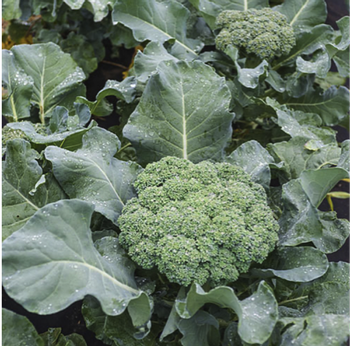Broccoli
-
Scientific NameBrassica oleacea
-
General InformationBroccoli is a cool season plant in the mustard family consisting of an edible flower head, stems, and leaves. There are short season and long season varieties. You can grow broccoli in the spring and again in the fall. Broccoli is delicious eaten fresh out of the garden.
 Photo: Guerney’s Seed and Nursery Co.
Photo: Guerney’s Seed and Nursery Co. -
When to Plant
Start seeds indoors mid-December through July. Plant short-season transplants (55 to 85 days to maturity) mid-February or March for a late spring harvest. In cooler areas, plant short or long variety in mid-July to mid-August; short-season plants will mature in late summer/fall, long-season (85 to 200 days to maturity) between December and March. In warmer areas, plant short season transplants in September. Optimum soil temperature is from 55 to 75 degrees. Be aware that young plants may stunt if temperatures approach freezing.
-
Planting
Select disease-resistant varieties. Avoid planting where this plant family has been grown within the past three years. Sow seed a quarter-inch to a half-inch deep and a half-inch apart in seed trays. Sow seeds or plant seedlings about 15 inches apart in the garden. Seeds sown closer together should be thinned as young plants.
-
Soil Requirements
Soil should be slightly acidic (6 to 6.8 pH). Seedlings do best in nitrogen rich soil high in organic matter with potassium, calcium, and magnesium. Soil should drain well.
-
Water Requirements
Provide ample regular water (two to three times per week depending on weather).
Water less if leaves begin to turn yellowish.
-
Fertilizing
Two to three weeks after planting, feed with fish emulsion, seaweed extract or compost tea to encourage vegetative growth.
An organic mulch will add nutrients and help suppress weed growth.
-
Pollination
Requires pollinators for fertilization.
-
Harvesting
Cut when the central head stops enlarging and flower buds are still tightly closed (typically late October/November).
If cut several inches below the head, smaller heads will form on side stalks if the variety is a sprouter (which most are).
If the head flowers, the plant will cease production.
-
Storage
Refrigerate for up to a week or freeze.
-
Good Varieties for Marin
‘Thompson’ ‘Apollo’ ‘Veronica’
Short-season with staggered maturity: ‘De Cicco’ ‘Calabrese’ ‘Green Goliath’ ‘Umpqua’, ‘Nutribud’ ‘Premium Crop F1’ ‘Packman F1’
Long-season: ‘Shogun F1’ ‘Purple Sprouting’ ‘Rudolph’ ‘White Star’
Romanesco varieties: ‘Veronica F1’ ‘Minaret’ ‘Waltham 29’ -
Helpful Tips
Practice crop rotation. Keep soil moist but not saturated. Avoid growing in too much hot or cold weather. Replenish soils annually with nutrients.
-
Common Problems
Caterpillars and cabbage worms can be removed by hand or treated with Bacillus thuringiensis (Bt) if paper collars around the base of plants and row covers are not effective. To control aphids, blast them off with a hose or apply insecticidal soap. If aphids are on harvested plants, soak in warm water with a little white vinegar until they release and float to the top. Chewers like harlequin bugs, slugs and snails can be handpicked and squished. To encourage beneficial insects, plant aromatic herbs nearby.
-
Pests- Diseases & More

